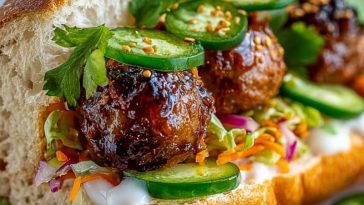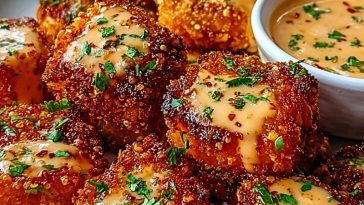Simple Cottage Cheese Flatbread Recipe – Easy & Quick
Cottage Cheese Flatbread is a wholesome, protein-rich bread alternative that is soft, flexible, and surprisingly satisfying. It is a recipe that takes a simple ingredient like cottage cheese and transforms it into a bread that can be used in countless ways. Whether you want to enjoy it as a wrap, use it as the base for mini pizzas, or pair it with soups and dips, this flatbread delivers on both flavor and nutrition.
Unlike traditional breads that often require yeast, kneading, and rising, this recipe is refreshingly simple and quick. With only a handful of ingredients, you can prepare the batter in minutes, and the baking process takes less than half an hour. The cottage cheese not only brings creaminess and tenderness but also provides a boost of protein, making the bread filling without being heavy.
This recipe is a wonderful choice for those who want a lighter bread option without giving up on taste or versatility. Whether you are meal prepping for the week, looking for a healthier bread substitute, or just curious about creative ways to use cottage cheese, this flatbread is one you’ll find yourself returning to again and again.
Why You’ll Love Cottage Cheese Flatbread
What Kind of Cottage Cheese Works Best?
For best results, it is recommended to use small-curd or whipped cottage cheese because they have a smoother texture that blends well with the other ingredients. If your cottage cheese is large-curd and chunky, you can blend it in a food processor to make it creamy before adding it to the recipe. While low-fat cottage cheese works perfectly fine, whole milk cottage cheese provides a richer taste and creamier consistency, which enhances the overall texture of the flatbread. Also, draining off any extra liquid helps keep the batter thick and prevents the flatbreads from turning soggy.
Options for Substitutions
- Cottage cheese can be replaced with other creamy bases if needed. Greek yogurt or ricotta cheese make excellent alternatives, and both will provide a slightly different but still delicious flavor and texture to the flatbreads.
- The type of flour you use can be adjusted based on your dietary needs. Almond flour or oat flour work well for those avoiding regular all-purpose flour, and a gluten-free flour blend can also be substituted to make the recipe entirely gluten-free.
- Eggs, which help bind the batter, can be swapped out in vegan-friendly versions. Flaxseed meal or chia seeds mixed with water act as good replacements, though the texture may turn out slightly denser than when using eggs.
- The seasoning profile is very flexible and can be adjusted to suit your preferences. Garlic powder, onion powder, Italian herbs, or chili flakes can be added to enhance the flavor and give your flatbreads a unique twist.
- Extra toppings can be included to make the flatbreads more exciting. Sprinkling sesame seeds, sunflower seeds, or shredded cheese on top before baking adds texture, crunch, and additional flavor.
Ingredients for Cottage Cheese Flatbread
Step-by-Step Instructions
Step 1 – Prepare the cottage cheese
Drain any excess liquid from the cottage cheese so the batter does not become runny. If your cottage cheese has larger curds, blend it in a food processor until smooth to ensure the flatbread has an even consistency.
Step 2 – Mix the wet ingredients
In a mixing bowl, whisk together the cottage cheese and eggs until the mixture looks smooth and combined. This step ensures the base of your batter is creamy and holds together properly.
Step 3 – Add dry ingredients
Add the flour, baking powder, and salt to the bowl. Mix until you have a thick but spreadable batter. If it feels too loose, add a little extra flour; if it seems too thick, loosen it with a splash of milk.
Step 4 – Incorporate oil and flavorings
Stir in olive oil and fold in any herbs, spices, or seasonings you want to include. This is the step where you can personalize the flavor profile of your flatbreads.

Step 5 – Shape the flatbreads
Line a baking sheet with parchment paper. Spoon portions of the batter onto the sheet and spread them into round or oval shapes about ¼ inch thick. Keep them even in thickness so they bake uniformly.
Step 6 – Bake the flatbreads
Transfer the baking sheet to an oven preheated to 375°F (190°C). Bake for 18–22 minutes, or until the flatbreads turn golden brown around the edges and feel set in the center.
Step 7 – Cool and serve
Allow the flatbreads to cool slightly before removing them from the parchment paper. Serve warm and use them as wraps, sandwiches, or bases for toppings.
How Long to Cook
The Cottage Cheese Flatbread typically bake for 18 to 22 minutes at 375°F (190°C). They are ready when the edges are golden and the centers are firm yet still flexible. If you prefer them crispier, you can leave them in for an additional two to three minutes.
Tips for Success
Watch Out for These Mistakes
What to Serve with Cottage Cheese Flatbread
Storage Instructions
Cottage Cheese Flatbread can be stored in an airtight container in the refrigerator for up to four days. To enjoy them warm again, reheat the flatbreads in a skillet or toaster oven until they regain their soft and flexible texture. For longer storage, you can freeze the flatbreads for up to one month, separating each flatbread with parchment paper to prevent sticking. When ready to use, thaw them at room temperature and reheat before serving.

Estimated Nutrition (per flatbread, approx.)
|
Calories |
120 kcal |
|
Protein |
8g |
|
Fat |
5g |
|
Saturated Fat |
3g |
|
Carbohydrates |
10g |
|
Sugar |
1g |
|
Cholesterol |
55g |
|
Sodium |
250g |
Frequently Asked Questions
Conclusion
Cottage Cheese Flatbread is an easy, nutritious, and versatile recipe that proves bread alternatives do not have to be boring. With just a few simple ingredients, you can make soft, flexible flatbreads that are high in protein, lower in carbs, and adaptable to countless meal ideas.
Whether you enjoy them fresh out of the oven, as a wrap stuffed with your favorite fillings, or topped with sauce and cheese as a personal pizza, these flatbreads are sure to become a staple in your kitchen. Healthy, delicious, and endlessly customizable, this is the kind of recipe you will want to make again and again.






